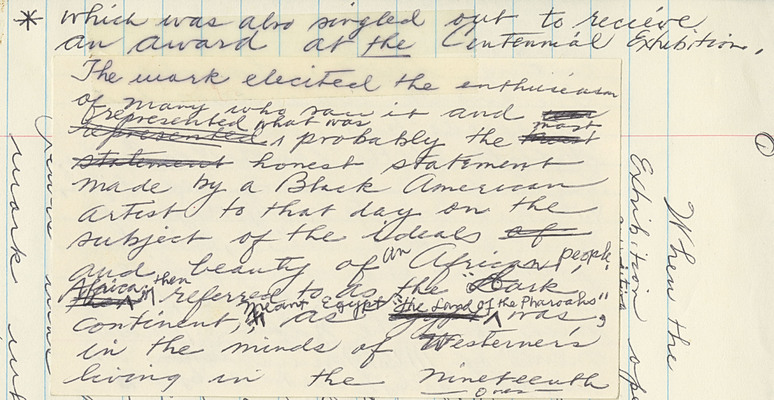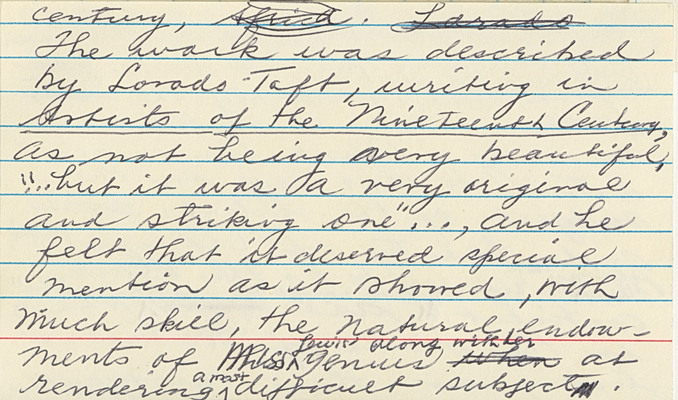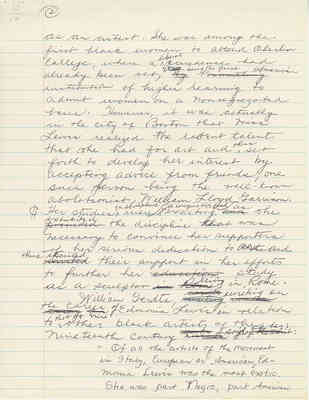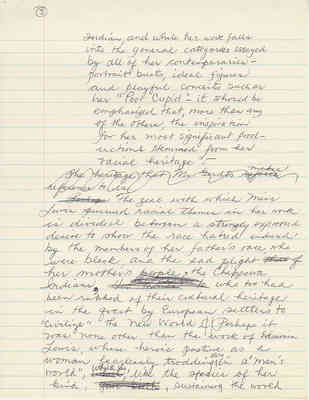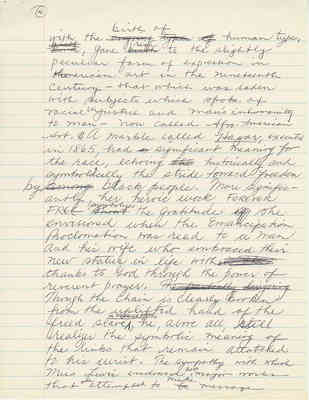Pages
MS01.01.03.B02.F10.041
* Which was also singled out to receive. an award at the Centennial Exhibition. The work elicited the enthusiasm of many who saw it and most represented what was probably the [struck out: illegible] honest statement made by a Black American artist to that day on the subject of the Ideals [struck out: of] and beauty of an African people, Africa; then referred to as the dark continent Egypt "The Land of the Pharoahs' in the mids of Westerners licing in the nineteenth"
MS01.01.03.B02.F10.042
century, ["Africa" Scribbled out]. ["Larado" Scribbled out]. The work was described by Lorado Taft, writing in Artists of the Nineteenth Century as not having a very beautiful, "but it was very original and striking one"..., and he felt that id deserved special mention as it showed, with much skill, the natural endow-ments of [Scribble?] Lewis alonng with her genius ["when" scribbled out] at rendering a most difficult subject ["s" scribbled out].
MS01.01.03.B02.F10.043
59 42 --- 16
2
as an artist artist. She was among the first black women to attend Oberlin College, where a liberal precendence had already been seen [?], being the first American institution of higher learning to admit women on a nonsegregated basis. However, it was actually in the city of Boston that Miss Lewis realized the ladent [?] talent that she had for art and thus set forth to develop her interest by accepting advice from friends, one such person being the well-known aboloitionist William Lloyd Garrison. Her studies in sculpture were imaginative and as exacting as she exhibited the discipline that [Scribbled out] was necessary to convince her supporters of her serious dedication to [art scribbled out] and this excited their support in her efforts to further her [education, strike through] study as a sculptor living in Rome. William Gerdts writing on the career of Edmonia Lewis in relation to that of nine other black artists of the Nineteenth Century said "Of all the artist of the movement in Italy, European or American, Ed [Education?] - Monia Lewis was the most exotic. She was part Negro, part American
MS01.01.03.B02.F10.044
Indian, and while her work falls into the general categories essayed by all of her contemporariesn-portrait busts, ideal figuresnand playful conceits such as her "Poor Cupid" - it should be emphasized that, more than any others, the inspiration for her most significant proud - actions stemmed from her racial heritage". - [The heritage that Mr. Gerdts makes reference to...Scribbled out] [Perhaps, scribbled out]. the zeal with which Miss Lewis pursued racial Themes in her work is divided between a strongly expressed desire to show the race hatred endured by the members of her father's race, who were black and the sad plight [that scribbled out] of her mother's people; the Chippewa Indians, who too had been robbed of their cultural heritage in the quest by European settlers to "Civilize" the New World. Perhaps is was none other than the work of Edmonia Lewis, whose heroic pastime [?] as a woman fearlessly trodding along in a "man's world", which she, like the species of her kind [gave birth - Scribbled out], sustaining the world
MS01.01.03.B02.F10.045
with the birth of human types, gave risk to the slightly peculiar form of expression in American art in the nineteenth century - that which was laden with subjects which spoke at racial injustice and man's inhumanity to man - now called Afro-American Art. A marble called Hagar, executed in 1865, had significant meaning for the race, echoing historically and symbolically the stride toward freedom by black people. More significantly, her heroic work FOREVER FREE symbolizes the gratitude she envisioned when the Emancipation Proclamation was read to a man and his wife who embraced their new status in life with thanks to God through the power of reverent prayer. Though the chain is clearly broken from the uplifted hand of the freed slave in FOREVER FREE, he, above all, still realizes the symbolic meaning of the links that remain attached to his wrist. The sympathy with which Miss Lewis endowed these major works that she attempted to make message.
